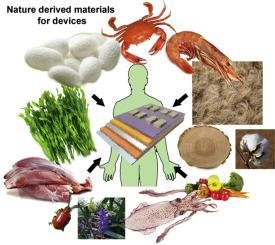Materials Today Bio ( IF 8.7 ) Pub Date : 2020-06-12 , DOI: 10.1016/j.mtbio.2020.100065 S Pradhan 1 , A K Brooks 1 , V K Yadavalli 1

|
Nature provides an incredible source of inspiration, structural concepts, and materials toward applications to improve the lives of people around the world, while preserving ecosystems, and addressing environmental sustainability. In particular, materials derived from animal and plant sources can provide low-cost, renewable building blocks for such applications. Nature-derived materials are of interest for their properties of biodegradability, bioconformability, biorecognition, self-repair, and stimuli response. While long used in tissue engineering and regenerative medicine, their use in functional devices such as (bio)electronics, sensors, and optical systems for healthcare and biomonitoring is finding increasing attention. The objective of this review is to cover the varied nature derived and sourced materials currently used in active biodevices and components that possess electrical or electronic behavior. We discuss materials ranging from proteins and polypeptides such as silk and collagen, polysaccharides including chitin and cellulose, to seaweed derived biomaterials, and DNA. These materials may be used as passive substrates or support architectures and often, as the functional elements either by themselves or as biocomposites. We further discuss natural pigments such as melanin and indigo that serve as active elements in devices. Increasingly, combinations of different biomaterials are being used to address the challenges of fabrication and performance in human monitoring or medicine. Finally, this review gives perspectives on the sourcing, processing, degradation, and biocompatibility of these materials. This rapidly growing multidisciplinary area of research will be advanced by a systematic understanding of nature-inspired materials and design concepts in (bio)electronic devices.
中文翻译:

用于制造功能性生物设备的天然材料。
大自然为改善世界各地人们的生活、同时保护生态系统和解决环境可持续性问题的应用提供了令人难以置信的灵感、结构概念和材料。特别是,源自动物和植物来源的材料可以为此类应用提供低成本、可再生的构建模块。天然材料因其生物可降解性、生物适应性、生物识别、自我修复和刺激响应等特性而备受关注。虽然长期用于组织工程和再生医学,但它们在用于医疗保健和生物监测的(生物)电子、传感器和光学系统等功能设备中的应用也越来越受到关注。本次审查的目的是涵盖目前在具有电气或电子行为的活性生物设备和组件中使用的各种天然衍生材料和来源材料。我们讨论的材料范围从蛋白质和多肽(如丝和胶原蛋白)、多糖(包括甲壳素和纤维素)到海藻衍生的生物材料和 DNA。这些材料可用作无源基材或支撑结构,并且通常单独用作功能元件或用作生物复合材料。我们进一步讨论了作为设备活性元素的天然色素,例如黑色素和靛蓝。越来越多地使用不同生物材料的组合来解决人体监测或医学中的制造和性能挑战。最后,本综述对这些材料的采购、加工、降解和生物相容性提出了看法。 通过对(生物)电子设备中受自然启发的材料和设计概念的系统理解,这一快速发展的多学科研究领域将得到推进。











































 京公网安备 11010802027423号
京公网安备 11010802027423号